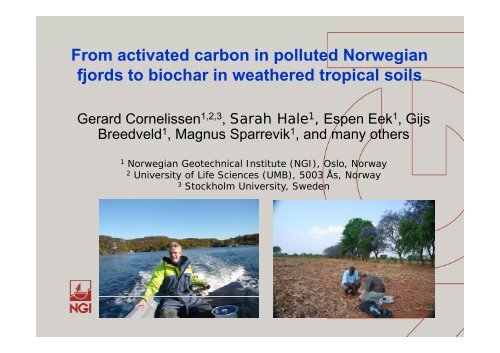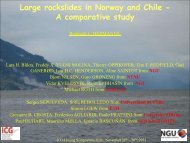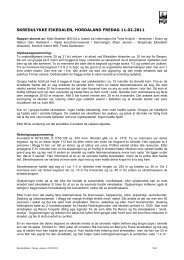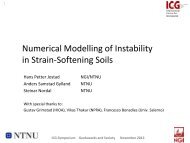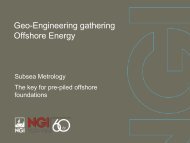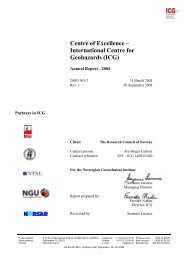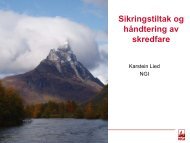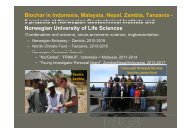From activated carbon in polluted Norwegian fjords to biochar ... - NGI
From activated carbon in polluted Norwegian fjords to biochar ... - NGI
From activated carbon in polluted Norwegian fjords to biochar ... - NGI
You also want an ePaper? Increase the reach of your titles
YUMPU automatically turns print PDFs into web optimized ePapers that Google loves.
<strong>From</strong> <strong>activated</strong> <strong>carbon</strong> <strong>in</strong> <strong>polluted</strong> <strong>Norwegian</strong><strong>fjords</strong> <strong>to</strong> <strong>biochar</strong> <strong>in</strong> weathered tropical soilsGerard Cornelissen 1,2,3 , Sarah Hale 1 , Espen Eek 1 , GijsBreedveld 1 , Magnus Sparrevik 1 , and many others1<strong>Norwegian</strong> Geotechnical Institute (<strong>NGI</strong>), Oslo, Norway2 University of Life Sciences (UMB), 5003 Ås, Norway3S<strong>to</strong>ckholm University, Sweden
Presentation Outl<strong>in</strong>eA. Polluted fjord sediment and th<strong>in</strong> caps with AC• 3 projects, Research Council Project andJo<strong>in</strong>t Industry ProjectB. Biochar <strong>in</strong> agricultural soil: agronomy and technology• Zambia• Indonesia• Malaysia• Nepal
Case study 1:Field study AC amendmentTrondheim Harbour, PAHsReferenceField(do noth<strong>in</strong>g)50 m50 mACpowderAC powder+sandsandAC powder+clay
Field application site2007-2010AC+ clayAC only
AC placementAC + clay best: lowest AC loss, bestchemical and biological effectOnly ACAC+clay after 5 monthsAC+sandCornelissen, G; Kruså, ME; Breedveld, GD; Eek, E; Oen, AM; Arp, HP; Raymond, C; Samuelsson, G; Hedman, JE; S<strong>to</strong>kland, Ø;Gunnarsson, JS. Remediation of contam<strong>in</strong>ated mar<strong>in</strong>e sediment us<strong>in</strong>g th<strong>in</strong>-layer capp<strong>in</strong>g with <strong>activated</strong> <strong>carbon</strong>--a field experiment<strong>in</strong> Trondheim harbor, Norway. Environmental science & technology 2011;45(14):6110-6.
Pollutant flux from sediment <strong>to</strong> waterCornelissen, G; Kruså, ME; Breedveld, GD; Eek, E; Oen, AM; Arp, HP; Raymond, C; Samuelsson, G; Hedman, JE; S<strong>to</strong>kland, Ø;Gunnarsson, JS. Remediation of contam<strong>in</strong>ated mar<strong>in</strong>e sediment us<strong>in</strong>g th<strong>in</strong>-layer capp<strong>in</strong>g with <strong>activated</strong> <strong>carbon</strong>--a field experiment<strong>in</strong> Trondheim harbor, Norway. Environmental science & technology 2011;45(14):6110-6.
Bioaccumulation and biodiversityAC+clay most benign
Field test 2:Grenland<strong>fjords</strong>,diox<strong>in</strong>s
53 km 2 <strong>polluted</strong> by Mg smelterMg smelterComparison of AC withcrushed limes<strong>to</strong>ne andlocal clean clayEidangerfjordOrmerfjordTests at 30 and 100 mdepthpGoogle EarthTest fields up <strong>to</strong> 40,000 m 2
How <strong>to</strong> place 80tAC and d20t salt on the seafloor?
Mix<strong>in</strong>g on boardDredg<strong>in</strong>g clean clayMix<strong>in</strong>g AC and clay
Determ<strong>in</strong>ation of layer thicknessLimes<strong>to</strong>neClayClay+ACReference
Reduction of diox<strong>in</strong> flux from sediment by 50-90%Gerard Cornelissen, Katja Amstaetter, Audun Hauge, Morten Schaann<strong>in</strong>g, Bjørnar Beylich, Jonas S. Gunnarsson, Gijs D.Breedveld, Amy M.P. Oen, and Espen Eek. Large-Scale Field Study on Th<strong>in</strong>-Layer Capp<strong>in</strong>g of Mar<strong>in</strong>e PCDD/F-Contam<strong>in</strong>atedSediments <strong>in</strong> Grenland<strong>fjords</strong>, Norway: Physicochemical Effects. Environ. Sci. Technol., 2012, 46, 12030-12037.
Reduction of diox<strong>in</strong> uptake <strong>in</strong> organisms:<strong>in</strong>creases over time for passive caps, stays low for ACSnail Snail Worm6 months 18 months 18 monthsLimes<strong>to</strong>ne 9 % 54 % 189 %Clean Clay 14 % 79 % 93 %Clay + AC 30 m depth 12 % 14 % 17 %Clay + AC 100 m depth 33 % 17 % 25 %
Case study 3:Fiskerstrand, TriButylT<strong>in</strong>n
Field siteArea of greatest contam<strong>in</strong>ationCalcite onlyCalcite and AC
Reduction <strong>in</strong> TBT concentration above sedimentC w (ng L ‐1 )16.014.012.010.008.06.040 4.02.00.0Before capp<strong>in</strong>g1 month after8 months after12 months aftercapp<strong>in</strong>g capp<strong>in</strong>g capp<strong>in</strong>gTest field capped with BiokalkTest field capped with AC and Biokalk
Susta<strong>in</strong>able solutions; Life-Cycle Analysissediment remediation: use <strong>biochar</strong>!”Do noth<strong>in</strong>g”NRClayHuman HealthEcosystemsResourcesLime”Coal AC”AC (coal based)”Biochar”AC (coconutwaste)‐10 ‐5 0 5 10 15 20 25 30 35Weighted damage mPtSparrevik, M; Saloranta, T; Cornelissen, G; Eek, E; Fet, AM; Breedveld, GD; L<strong>in</strong>kov, I. Use of life cycle assessments <strong>to</strong> evaluate theenvironmental footpr<strong>in</strong>t of contam<strong>in</strong>ated sediment remediation. Environmental science & technology 2011;45(10):4235-41.


